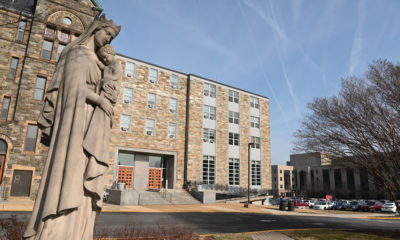Living
College survival guide
Recent LGBT graduates share tips and tools to help you thrive on campus


Always remember the buck stops with you on personal matters. It’s OK to say no to coming out, to sex, to too much involvement or anything else during your college years.
Looking back on my four years as an undergraduate, I’m reminded of all the beautiful friends I met, the wonderful places I was lucky enough to go and the life-changing experiences I was able to have.
College is truly a time for individuals to grow, not only academically and professionally, but on an important personal level as well. As with all matters of life however, there is certainly a flux and flow of the good and the not so good.
Venturing into any unknown situation is intimidating. If you’re LGBT and about to start college, here are some suggestions from a few of us who were just there.
For starters, be sure to find a campus that you’re going to enjoy. A sense of belonging should be high on your college priority list. You do not want to enroll in a campus and then discover that parts of your identity are not welcomed or even celebrated. In this sense, it is perfectly OK to be selfish. Find a campus that you enjoy as much as it enjoys you. As a great resource, check out Campus Pride’s National Listing of LGBTQ-friendly colleges and universities at campusprideindex.org.
When to come out? If you do not feel that it’s the right time for you to come out during college, know that it’s your decision to make. Everyone has his or her own story and own time to tell it. Never feel pressured to come out. Do it at your own pace. Period.
“Honestly, I wish I had been told that I do not have to be out if I do not want to,” says Mariam, a 2015 graduate of the University of Michigan-Dearborn. “There was this huge emphasis on my campus for ‘Coming Out Day’ and it’s not always safe to.“
The only person capable enough to decide how many things you can take on in college is yourself. Do not stretch yourself too thin, too fast. Remember that you have four or more years to engage in everything you want to engage in. Take your time. Remember to balance your academic as well as your self care as priorities.
“Know your limits,” says Matthew, a 2015 Illinois State University graduate. “I always felt on the outside as a queer individual growing up, so when college came around I tried including myself in everything I could get my hands on. Pick a few things you love and rock out on them.”
On a similar note, do not forget that you are allowed to say “no.” Many people fall into a pattern of saying yes to everything that comes their way. This is a quick way to become overworked and even out of tune with yourself. Your college years are the time to experiment and get involved with as much as you can. However, if you’re not willing or able to, there’s a simple, one-word solution — no.
Sex: let’s get real. How honest would an article about college life be if it did not involve anything regarding sex? The answer: not that honest. Sex isn’t a priority for everyone and that’s perfectly fine. However, if you’re having sex then make sure you and your partner(s) are safe and comfortable. In terms of safe sex, many colleges and universities have departments or programs that provide safe-sex resources such as condoms (male and female), dental dams, lubrication, etc. In terms of comfortable sex, make sure that all parties in the encounter give their clear consent. Do not put yourself or someone else in a position that they do not feel ready for. Communication is key. Sex is great, but we have to be able to talk about it first.
Making healthy choices. LGBTQ college students face many challenges that impact their health and well-being on campus. Whether alcohol/substance use or healthy body image issues, there are specific ways these health concerns affect LGBTQ youth differently. Educate yourself and your campus community on the issues related to LGBTQ health and wellness by checking out Campus Pride’s Health and Wellness resources at CampusPride.org/resources
Fabulous, of course. Remember that while you may have amazing circles of support on your campus, parts of the world are still catching up to your fabulousness. When you’re searching for internships or post-graduate positions, do your research. Make sure you find an organization or company that is going to make you feel safe and welcome for all your identities.
“I wish that someone had given me advice on how and where to find employers and geographical locations that are LGBTQ-friendly,” Mariam says. “So looking for an after graduation-job would have been much easier, ya know? I wish that was something career offices made available on the regular: companies that are specifically LGBTQ-friendly.”
Take advantage of the resources your campus has to offer. Many universities have programs designed to help advance the wellness of students. Whether it be through a Career Center, Counseling Services, a Student Involvement Center, an Office of Diversity Advocacy, or even the Campus Recreation Center. Most of the services these departments will provide are of no cost to students. You already paid for much of these resources in your tuition, so take advantage of them.
“I wish someone would have prepped me for what the world feels like when you’re no longer directly protected by the resources and support of a university that provides for LGBTQ students,” says Roze, a University of Missouri-Kansas 2014 graduate.
Making friends outside your circle. Meet up and make friends with people from all walks of life. In doing so, you will be exposed to a rainbow of different ways to view and engage with the world. As this might be a scary thought at first, know that diversifying your experiences will only further your growth as a young adult. As LGBTQ individuals, it’s important to remember intersectionality and that those who may support us also need support in return.
“One thing no one told me is that it’s really easy to get involved in queer/trans issues even if you do not work for a QT organization,” says Kayla, a 2014 graduate of Texas A&M University. “There are all types of community organizations in big cities, college towns, medium-sized cities, etc., and they’re always looking for people. Also, if you’re looking to meet other QT folks, look for a meetup group (meetup.com) or create one if there’s not one in your area.”
Look for role models and mentors. In your search for support and friends, also aim your sights on finding a personal role model or mentor or even multiple. Sometimes it is easier for someone to know what they want in life by observing how others have engaged with the world. Mentors or role models are an incredible source of information and often much more experience in areas you may be interested in yourself.
“It is important to find a mentor,” says Matthew, a 2015 Illinois State University graduate. “I was so, so lucky to have many amazing mentors in college. Queer individuals should always have someone to ask questions of, lean on and be challenged by for growth.”
Selfie care: This is about more than taking time to snap a photo. One of the most important things to remember, not only in college but in all stages of your life, is self care. College can be incredibly busy and stressful at times. Remember that it is OK for you to take a step back and spend time on yourself if you need to. Constructive self-care time will better allow you to take on responsibilities as a student.
“Knowing what I know now about being a queer college student with one degree under my belt, I make a point of telling my students now that they are not alone, that their feelings are valid, and that they are already defying odds by being in college,” Roze says. “So if self care takes precedent over an assignment sometimes, there are always ways to improve your grade, but you have to improve yourself first.”
Why am I here? Never forget the reason you’re in higher education. Have goals and remember that you are there to graduate and receive an education. Sure, it’s easy to doze off and daydream during a long lecture. But what good are you doing yourself if you’re not paying attention to the material? Not only is it a waste of your money, but it is also a waste of your time and growth as a future activist.
“Education is a privilege and access to the language of theory is not something most people have,” says Megan, a 2015 graduate of Metropolitan State College of Denver. “If you cannot back up your theory with actions then what you are left with is a language without meaning. It’s not easy to reframe the way I talk about power and identity outside of academic circles, but I have realized that inaccessible language is a barrier to inclusive social justice.”
With these tools in your back pocket, my hope is that you’re ready to tackle higher education head on. There’s no such thing as too much advice, so don’t stop with this article. Be sure to reach out to those you may know who have experienced higher education for more tips and tools. Always remain proactive, get involved, but to also take time for yourself. Stay fine, fresh and fierce and enjoy every moment you can. These are the glory days.
Tyler Eilts is an alumnus of Illinois State University, where he is also seeking his master’s degree in interpersonal communication and women’s and gender studies. He is a 2015 summer fellow for Campus Pride.
Real Estate
Child- and pet-proofing your home for the holidays
It isn’t about being perfect but about being prepared

The holidays are meant to be joyful, cozy, and full of laughter — but if you have young children or pets, they can also feel a little chaotic. Twinkling lights, shiny decorations, guests coming and going, and tables full of tempting food can turn your home into a wonderland of curiosity and mischief. The good news? With a little thoughtful planning, you can keep the holiday magic alive while making your home safer for everyone who lives there.
There’s something oddly comforting about movies where animals go to war with holiday decorations, turning carefully strung lights and perfectly placed ornaments into chaos. Whether it’s a mischievous dog tangled in tinsel or a curious cat launching a full-scale assault on a Christmas tree, these scenes tap into a universal experience for pet owners.
The humor comes from the contrast: the human characters are trying to create warmth, tradition, and picture-perfect cheer, while the animals see the decorations as toys, obstacles, or personal enemies. The resulting destruction — trees tipping over, ornaments shattering, lights blinking out—feels exaggerated but relatable, especially during the already hectic holiday season.
Let’s start with decorations because they tend to be the biggest attraction. Ornaments sparkle, garlands dangle, and everything seems designed to be touched, pulled, or tasted. If you have little ones or pets, consider placing your most fragile ornaments higher on the tree and using shatterproof options on the lower branches. Tinsel and ribbon may look festive, but they can be dangerous if swallowed, so skipping them or keeping them well out of reach is a simple way to reduce risk without sacrificing style.
Holiday lights are another favorite fascination. Before hanging them, take a few minutes to inspect each strand for frayed wires or broken bulbs. Secure cords along walls or behind furniture so they’re harder to grab or chew and unplug them when you leave the house or head to bed. Not only does this help prevent accidents, but it also gives you one less thing to worry about during a busy season.
The Christmas tree itself can become a focal point for exploration. Make sure it’s sturdy and well-anchored so it doesn’t tip if a toddler tugs on a branch or a pet decides to investigate. If you use a real tree, cover the water base since tree water can contain additives that aren’t safe if consumed. For artificial trees, keep an eye out for loose pieces or needles that could become choking hazards.
Food is a big part of holiday celebrations, and it’s also one of the most common sources of trouble. Many traditional treats—like chocolate, grapes, raisins, alcohol, and foods containing xylitol—are dangerous for pets. Keep plates and serving dishes up high, secure the trash can, and gently remind guests not to slip pets or kids “just a little bite” without checking first. For children, be mindful of hard candies, nuts, and small treats that could pose choking risks.
Candles and fireplaces add warmth and charm, but they deserve extra caution. Flameless candles are a wonderful alternative if you want ambiance without worry. If you do use real candles, place them well out of reach and never leave them unattended. Fireplaces should always have a sturdy screen or gate, especially with crawling babies or curious pets nearby.
Holiday gatherings bring wonderful energy into your home, but they can also create new challenges. Doors opening frequently make it easier for pets to slip outside, so consider setting up a quiet, comfortable space where they can relax during busy get-togethers. This can help reduce stress for them and give you peace of mind. For children, stair gates, locked cabinets, and clear boundaries can help prevent accidents when there’s extra excitement in the air.
New toys and gifts are another thing to watch closely. Packaging, twist ties, plastic wrap, and especially button batteries should be cleaned up promptly. These items are easy to overlook in the excitement of gift-opening but can be dangerous if swallowed. Taking a few minutes to tidy up as you go can make a big difference.
Lastly, try to keep routines as steady as possible. The holidays naturally disrupt schedules, but familiar mealtimes, naps, walks, and bedtime rituals help children and pets feel secure. A calmer household often means fewer accidents and a happier experience for everyone.
At the end of the day, child- and pet-proofing your home for the holidays isn’t about being perfect but about being prepared. A few small adjustments can help you relax, enjoy your guests, and focus on what truly matters: creating warm, happy memories with the ones you love. When your home feels safe, the holidays feel even sweeter.
Valerie M. Blake is a licensed Associate Broker in D.C., Maryland, and Virginia with RLAH @properties. Call or text her at 202-246-8602, email her at [email protected] or follow her on Facebook at TheRealst8ofAffairs.
Real Estate
In real estate, trust the process
With rates coming down, we could see spring surge in buyers

The average 30-year mortgage rate is falling, little by slowly. With predictions that the rate will continue to adjust downward in the next year or two, there may be a busier spring market than we have seen in the last few year, especially for the DMV market, which has been reeling from thousands of layoffs this past year. The frenzied activity resulting from interest rates close to 3% for some borrowers will probably not occur; however, this spring could add up to be a few notches busier than the last.
What does this mean for buyers and sellers? Lender Tina Del Casale with Waterstone Mortgage says she has seen “low to mid 6’s as the average for conventional loans.” If rates continue downward into the 5% range, there may be more activity than we saw in the last year or two. This could release a little bit of pent up demand.
Many buyers will have found that for whatever reason, their current home is not meeting their needs. Sellers may want to finally take the plunge and put a for sale sign in the yard and online, now that they might find a more reasonable rate on their next home. This winter can be an opportunity to assess financial situations, home conditions, and optimize one’s chances to have a sale with more agreeable terms, or put one’s best foot forward in an offer. In addition to checking with a lender or favorite handy person, let’s review what sellers and buyers typically spend their energy negotiating while enjoying the lovely process called “going under contract”:
- Timelines – Sellers might want to have their house solidly under contract (papers signed, thumbs up from the lenders, all inspection items decided upon and settled) so that they can put an offer down on a new home, and then negotiate that timeline with the other sellers. Remember, making a move is not only about the buyer taking possession of a new home, but also about the sellers figuring out their situation as well.
- Sale Price – unfortunately for buyers, in the eyes of most sellers, “money talks.” So, in a non-competitive situation, a seller might be happy to just get one offer at a price that was within the desired range. As soon as another interested buyer enters the equation, it can become a little bit like RuPaul’s Drag Race, and one will have to lip sync for one’s life, honey! And only one buyer will get to hear the words, “condragulations!”
- Tone/Vibes/Energy in the Room – Remember: Human beings are emotional creatures. All of us have feelings. And all of us want to put energy into situations where we feel appreciated, where a level of self-awareness exists, and a sense that each side is trying one’s hardest to act in good faith. The best transactions I saw were where a little grace was the “grease on the wheels” of the transaction. Occasionally, a buyer had cold feet and wanted to see the unit a few more times before the settlement date, or a seller forgot to scrub the bathroom with a little extra elbow grease before the settlement date. Life happens; misunderstandings can occur. A wise therapist once said: “You don’t have to like it, but can you allow it?” The tone of one or both parties in the transaction can be what seals the deal, or results in one party exiting the contract. (In the case of the dirty bathroom, the seller left a check with the title company for the buyer to pay a housekeeper to come clean what they couldn’t.)
Joseph Hudson is a referral agent with Metro Referrals. He can be reached at 703-587-0597 or [email protected].
Real Estate
Signs you’ve outgrown self-management of your D.C. rental
Keeping up with local regulations is a struggle

According to rental market statistics from RentCafe, Washington, D.C., remains at the top of the most popular cities for rental properties. With a strong rental market and a growing population, success should be second nature to real estate investors and rental property owners in this area.
As a self-manager of your own rental, if you’re not enjoying the profitability and the earnings that this market can provide, it might be time to look for professional management.
There are certain signs that show property owners have outgrown self-management. We’re exploring those today, and inviting DIY landlords to consider the benefits that come with a partnership with a professional property management company in Washington, D.C.
Washington, D.C., is known for having a complex and ever-changing regulatory environment. There are strict tenant rights, rent control laws, and specific rules related to property maintenance such as mold, lead based paint hazards, among others. The Rental Housing Act of 1985 is strictly enforced, and under this program, there are specific rules regarding rent adjustments, dispute resolution, and eviction protections.
Fair housing laws need complete compliance, security deposits have strict timelines, and habitability standards are in place to ensure tenants are living in a home that’s safe and well-maintained.
Staying on top of these rules can be time-consuming and difficult. Violating even a small regulation unintentionally can result in fines or legal action. It’s critical to stay compliant, and if you find yourself struggling to keep up with the evolving laws and regulations, it’s a clear sign that you may need professional help. Property managers can reduce the risk and liability of making a legal mistake.
Financial Returns are Underwhelming
A lot of self-managing landlords choose to lease, manage, and maintain their own properties because they don’t want to pay a management fee. We get it. Keeping more of your money seems like the best way to increase profitability.
But, here’s the reality of it: property managers can help you earn more and spend less on your investment, increasing your earnings and your ROI. In fact, a good property manager can often earn enough additional net revenue for the owner to pay for that fee over a year.
Property managers are experienced at maximizing the financial performance of rental properties. We can help:
- Optimize rental income
- Reduce vacancy rates
- Lower maintenance costs through established vendor relationships
- Recommend improvements for higher values
Ultimately, a good property manager will ensure that your property is being run efficiently. We will use our expertise to ensure your property is earning what it should.
Maintenance and Repairs Are Taking Up Too Much Time
Maintenance challenges are not unique to self-managing rental property owners. We deal with them, too, as professional property managers. We respond to plumbing issues and appliance malfunctions, we take calls in the middle of the night when a sewer is backing up, and we work hard to protect properties against deterioration and general wear and tear.
This can be overwhelming, especially when it comes to finding vendors and service professionals that are both affordable and provide quality service. Plumbers, electricians, HVAC technicians, and even landscapers and cleaners are in high demand in Washington, D.C. But maintenance at your rental property cannot wait. It’s essential to the value and condition of your investment as well as to the product you are selling.
It’s time to work with a professional property manager if you’re having trouble finding vendors or if you’re struggling to keep up with maintenance requests. We have systems for emergency responses, routine repairs, and preventative services.
Tenant Screening Is Becoming More Difficult and Time-Consuming
Finding good tenants is one of the most critical aspects of rental property management. But in our home of Washington, D.C. we have one of the most regulated rental markets in the country. The tenant screening process has become increasingly complex, highly restricted, and time-intensive.
Many property owners are surprised to learn that there are more limitations than ever on what can be screened, what information can be used in making a decision whom to rent to, and how screening decisions must be documented. Federal and local laws tightly regulate the use of credit histories, criminal background records, income verification, and even eviction records. Staying compliant is not optional. Failure to follow these rules can open the door to discrimination claims, administrative complaints, substantial fines, or even lawsuits.
That’s why rushing or relying on outdated methods can easily result in selecting the wrong resident or worse, unintentionally violating DC’s Human Rights Act or federal Fair Housing laws.
Problematic tenants often become evident only after move-in: lease breaks, chronic late payments, noise complaints, and property damage. When these patterns appear repeatedly, it is often a sign that the screening process is not sufficiently structured.
Why Professional Screening Matters
Professional property managers have systems in place to perform thorough, legally compliant screening while avoiding oversteps that could violate the regulations. Professional property managers use trusted screening platforms and follow written processes that keep owners protected and ensure fairness for applicants.
Columbia Property Management’s screening process includes:
- Credit Report Review
Evaluating credit patterns, payment reliability, and debt load while complying with restrictions on how data can be used. - Rental History Verification
Contacting prior landlords and reviewing national eviction databases—keeping in mind that some jurisdictions like the District of Columbia limit how far back eviction data can be seen, must less considered. - Background ChecksReviewing public records in a manner consistent with DC’s Human Rights Act and federal guidance on criminal history usage. Not all criminal records can be considered in rental decisions, and timing rules often apply.
- Income & Employment Verification
Confirming applicants can afford the rent and other monthly expenses based on their income, without ruling out certain income in a discriminatory way (e.g., vouchers, subsidies, or lawful alternative forms of income). There are many intentional steps conducted by professional property managers under a framework that ensures decisions are based on objective criteria, applied consistently, and fully aligned with the latest federal and DC regulations.
Your Property Is Sitting Vacant for Longer Periods
While current rental market dynamics are starting to show the effects of federal workforce layoffs and the worsening local economy, the vacancy rate in Washington, D.C., is relatively low, compared to the national average. According to a news report from WTOP, the local vacancy rate is just 6%, and there are an average of seven applications for every available rental unit.
A vacant rental property can quickly become a financial drain. Whether you own a condo near Dupont Circle or a single-family home in one of Capitol Hill’s neighborhoods, every day your property sits empty means lost income. While the D.C. market is generally competitive, the reality is that there are always fluctuations in demand based on seasons, neighborhood desirability, and even economic trends.
If you’re struggling to fill your rental quickly, it might be a sign that you need to re-evaluate your approach. An experienced property management company has a marketing strategy in place to keep vacancy periods as short as possible. From professional photos and listings to leveraging established networks, they can help ensure that your property is rented quickly, reducing the amount of time it sits vacant.
While managing a rental property in Washington, D.C., can be rewarding, it’s also challenging. As your property portfolio grows or the demands of your life or the demands of being a landlord increase, it’s helpful to recognize when it’s time to step back and let a professional handle the day-to-day tasks.
From navigating complex local regulations to ensuring your property remains occupied and well-maintained, there are many reasons why rental property owners in Washington, D.C., outgrow self-management. If any of these signs resonate with you, consider partnering with a property management company like ours to ensure that your rental investment continues to thrive without the stress and burnout of self-management.
We’d love to be your Washington, D.C., property management partner and resource. Please contact us at 888-857-6594 or ColumbiaPM.com
Scott Bloom is owner and Senior Property Manager, Columbia Property Management.
-

 Politics4 days ago
Politics4 days agoLGBTQ Democrats say they’re ready to fight to win in 2026
-

 District of Columbia4 days ago
District of Columbia4 days agoBrian Footer suspends campaign for Ward 1 D.C. Council seat
-

 Opinions4 days ago
Opinions4 days agoLighting candles in a time of exhaustion
-

 Opinions4 days ago
Opinions4 days ago2026 elections will bring major changes to D.C. government




















